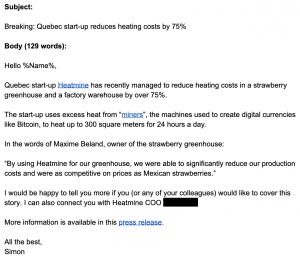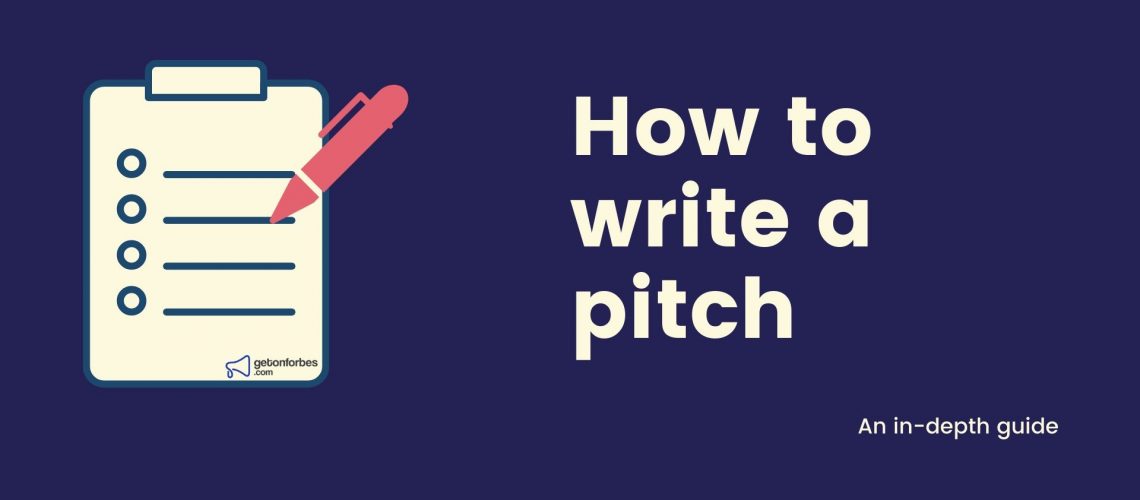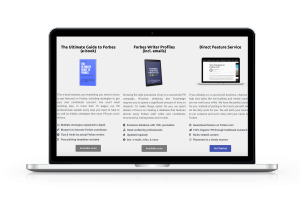One of the most essential steps to get featured in a Forbes article is writing a pitch and sharing your story with some of their hundreds, if not thousands of active writers.
In our previous guides, we already explained how to find Forbes journalists for your niche, how to find their email addresses, and what strategies you can use to get your pitch in front of the right people.
In this article, we will shed light on how you find the right angle for your Forbes pitch, what an excellent pitch is made of, and how you can ultimately write it.
Let’s dive right in.
How to find the right angle for your Forbes pitch
Finding the right angle is key to every PR pitch. In fact, we would argue that it is much more important than the actual content of your pitch, its format, or your writing style.
A story angle can make or break your pitch. Here are three different categories that you should consider when looking for the perfect perspective on your business
1. General stories
If your company is doing something revolutionary, if it is re-inventing an old model or cleverly building on a successful idea, you might be in luck. A general story, on your business, your product, or even yourself as a businessman can easily make it to Forbes if you manage to present it in a great light.

A general story on Forbes looks like this
We would argue that for most businesses, the first step is always to sit down and consider whether your company, product, or personality fits into it. Of course, you should have a strong understanding of your niche and industry, including your competitors, market leaders, and thought-leading entrepreneurs.
If you come to the conclusion that you’re up to something revolutionary indeed, you should start brainstorming bullet points that are most important about your business.
Ask yourself questions like “how old is the idea that I’m pursuing?”, “what does my business better than other companies?”, “how does my product or service help people”, “what aspects of my business are particularly impressive?”, and so on.
Collect all your ideas on a (virtual) piece of paper and narrow down the most significant elements. Perhaps one of your friends or partners happens to be in journalism, marketing, or communications – make sure to present your ideas and ask for their professional opinion.
Once you decided what your 1-3 biggest selling points are, it’s time to start with the next step.
Successful placements of general stories usually come with the most beneficial PR exposure. Nevertheless, they also tend to be the hardest to achieve.
2. Company news
Undoubtedly among the most efficient ways to convince Forbes authors to write about your business is company news.

This is an example for a news story on Forbes
Obviously, the level of ‘newsworthiness’ has a massive impact on how much interest will be generated. As a rule of thumb, most company news falls into one of three categories.
Partnerships
Depending on the type of business you’re running and the industry you are operating in, partnerships may or may not be an integral part of your business strategy. As long as your new partner is at least known in your niche, you will most probably find journalists that would love to learn more about the collaboration.
Nonetheless, you still have to reflect on whether the partnership actually includes newsworthy content and whether it is a real, mutual collaboration.
We’ve seen shady companies announcing partnerships with Microsoft just because they’re using some of their products. Unsurprisingly, such outlandish claims are often immediately falsified by either critical journalists or the supposed partner itself.
Products
Do you have a new product coming up that you consider ‘disruptive’, ‘revolutionary’, or ‘novel’? If this is really the case, I’m sure that a myriad of journalists would love to check it out.
In fact, pitching new products is not only some of the easiest ways to get PR features, but it often provides the best exposure you can hope for. That is, as long as your product is what you claim it to be.
To drastically increase your chances, make sure to offer any journalist to try out the product himself. If you’re dealing with physical products, always insert a personal note into the package, and if possible, add some other products as a bonus. Some journalists receive dozens of products a year, so you only really have one chance to make your product stand out.
In case you’re selling digital products, make sure to prepare a complimentary account or login for the reporters you’re reaching out to.
Other developments
Apart from partnerships and products, there is also a variety of other developments that many journalists might find newsworthy.
This includes expansion plans, research, marketing campaigns, internal affairs (think high profile employees), and numerous other aspects. We usually start with brainstorming even the tiniest recent developments and then filter out the ones that stand out.
3. Expert commentary
If you are running a business for several years or operating in a new market with a decent track record, the chances are good that people both in and outside your industry might see you as an expert. This provides an opportunity to position yourself as a specialist on issues such as business development, marketing, or research in a particular niche.
Forbes journalists are always looking out for experienced men and women who can speak from direct experience and use them as sources in their articles.

In this story, several experts comment on paying taxes
Reflect on yourself where your strengths are and what unique experiences you had in the past couple of years. This will help you formulate a formidable pitch in which you offer reporters an exclusive interview or comments on a certain issue.
When pitching expert commentaries, always try to refer to current events. Let’s say you are an expert in social media analytics and would like to get featured as an expert on Forbes.
Instead of merely pitching you as a specialist in social networks, wait for an event that is extensively discussed in the industry (e.g., Facebook’s Cambridge Analytica scandal, or Trump’s war with Twitter) to share insider or expert knowledge on the matter.
What do I need to prepare for crafting an excellent pitch?
There is one final step left before you should start writing your pitch. In this phase, you want to collect interesting data, useful material, and hidden knowledge. Let’s see what this involves.
1. Solid data
Many businesses love to talk about how great they are. Sure, it may be the case that your company is truly disruptive, or that your product is the Airbnb of <<insert industry>>, or your CEO may indeed be the new Mark Zuckerberg. You won’t believe how many times a journalist hears one of these phrases a year.
Whatever claims you make, it is always constructive to have robust data available to illustrate how your world looks.
Before even thinking about sending out a pitch, you should accumulate reliable facts and figures about your business, such as the number of customers, users, and employees, as well as metrics like your annual revenue, growth rate, and more.
Even if you don’t want to include any of this information in your initial pitch, it can become convenient for an interview with a journalist.
2. Additional material
In many cases, reporters will ask for more information on certain aspects of your business or person. You can and should always be prepared for this by collecting or even crafting additional material that should further illuminate certain aspects of your pitch.

A press release, e.g. on reputable platforms like Business Wire, can significantly increase your chances of being featured by the media
Classic elements that work well for this cause are press releases, one-pagers and presentations, professional images and videos, and similar files.
3. Insider info
As already mentioned in our section about expert commentaries, good journalists are always on the hunt for unique insider information.
Even if you’re not directly pitching commentaries, offering it as a little treat can make a journalist very curious. Be sure to frequently talk to colleagues and business owners in your niche, as this can reveal a lot of information that a reporter might find quite useful.
How to write the perfect pitch
By now, you should be able to determine the perfect angle and assemble all the necessary material and data for your pitch. Therefore, we can finally start talking about how to write the perfect pitch.
How long should a pitch be?
Before diving into the content of your pitch, let’s first talk briefly about the length of a pitch. As you might have already suspected, there isn’t a clear one-size-fits-all approach with regard to the extent of a pitch.
Actually, this is the case for any part of writing a pitch. Nevertheless, there are still some rough guidelines we advise to follow.
The length of a pitch is quite a significant aspect that many people might underestimate. In fact, from my experience, persons who don’t happen to have a background in communications or marketing often struggle with writing decent emails.
In general, you should always try to keep your pitches brief and only include vital aspects about the event or entity you’re pitching. In practice, this means that you should always keep your pitches below 200 words.
However, we advise aiming for only 130-140 words, and if at all possible, not exceeding 180 words.

This is a great example for a very brief pitch
The reason for this is simple. Most journalists receive dozens of email pitches every day and do not have the time to read any detailed messages. Thus, you want to catch their interest right away and make sure that they understand the key messages in less than a minute.
Email subjects
Subject lines represent a critical point in every outreach campaign. If they’re not impressive enough, no reporter will even bother to open your email.
However, if the recipients get a feeling that you’re overstating things, they might see it as spam and potentially even categorize it as such – which is pretty bad for your email reputation.
Thus, we’re looking to strike a balance between eye-catching and down to earth. In general, the subject should summarize the message of your pitch in a brief sentence and focus on the most newsworthy aspects of your pitch.
For instance, if you’re announcing a partnership with a known company or brand, make sure you put that name first in your subject line.
Moreover, you can also choose to send your pitches to a handful of journalists under embargo, or even offer to someone exclusively. When pitching under embargo or offering exclusives, you also want to add variations of “(EMBARGO)” or “(EXCLUSIVE”) to your subject line, so that the recipients immediately know that you’re pitching a limited number of reporters.
When it comes to word length, the email marketing experts at Campaign Monitor suggest using a range between 41 and 70 characters (the maximum visible widths for iPhones and Gmails). Since most journalists are working on a computer and not on a smartphone, we usually go for around 70 characters.
Pitch structure
It’s finally time to get into the details of your pitch. The following elements are vital aspects of a successful media pitch. So, read carefully and make sure that all of these parts are covered in your pitch draft.

This is an example for a very successful pitch that we used a while ago
Introduction
The first paragraph of a pitch is used to introduce your company and the event or aspect you’re pitching. You should try to complete the intro in only one sentence and include your company name, what your business is doing in 5-15 words, and what the event is about in 10-20 words.
If you’re sending out your emails individually, you can also create a more personal intro, where you reference some of the journalist’s recent work or other personal matters.
Main points
In the following section, you should aim to explain why this piece of information is exciting or newsworthy and answer the famous five Ws: Who, What, When, Where, and Why.
Due to the limited space, it is of great importance that you only include absolutely vital information – no redundant phrases, and no irrelevant information. Also, make sure to include any recognizable names that are involved in the announcement.
The main points section should have a length of two of four paragraphs, with each paragraph containing no more than two sentences (keep in mind that the total length of your pitch should be between 130 and 180 words).
This is the most critical part of every pitch. If reporters don’t consider the information newsworthy, they won’t even bother replying to you. If you’re inexperienced with PR, perhaps you are able to show your draft to a journalist friend or communications professional for further input.
In any case, do not rush this part and always think twice about every sentence you write.
Quote(s)
This part may not fit into every pitch, yet it can be extremely helpful in many situations.
What you may want to do next is insert a related quote from yourself, an executive of your company (CEO, COO, CTO, etc.), or a third party involved with the story you’re pitching.
We usually go for the third option, as it not only brings the benefit of social proof, but it also provides a perspective from the outside and shows that your partners are also committed to the event.
Once again, we always advise quoting the most relevant or the most known/reputable person. Content of the quote could be supplementary data (e.g., presented by a client or researcher of your team), an outlook on the future (e.g., forecasted by the CEO or CFO), or a brief success story.
The fishing pole
In the final section of your pitch, your goal is to get the fish out of the water.
To achieve this, you should let the reporter know that there is more detailed information available and that you’d be happy to send it over for review if he is interested in your story.
At this point, you can offer to forward a press release, exclusive quotes, images and videos, or additional documents. You should also always mention the possibility of an interview with yourself or a member of your team.

Most reporters who are interested in a pitch proceed with scheduling an interview
Of course, you can choose to include your press release or quotes directly in your initial email. However, we found that asking for a response before sending over explicit material yields a higher chance of success than merely including it right away.
Links
Furthermore, many PR specialists regularly include hyperlinks in their email pitches. It usually makes sense to include 1-5 links per pitch, though you should try to avoid them wherever necessary, as some email providers consider emails with too many links as spam.
We usually add links to a company website, third parties and especially known personalities (e.g., to a website, or a Twitter or LinkedIn account), and important news that is referenced in the article.
Attachments
Due to contemporary spam filter technologies and a generally bad reputation of attachments, you should under no circumstances add any attachments to your initial email.
If you want to include a document, image, video, or other file types in your pitch, whatever the reason may be, you first upload them to a server that allows accessing the file via links online. You can then insert a hyperlink to the data.
Writing pitches to Forbes journalists – final thoughts
Since you now know how to craft a successful pitch that gets you a story to Forbes, you may also want to learn about issues like finding Forbes reporters’ emails or becoming a Forbes contributor yourself.
You will learn these and more things in our guides How to Get Your Company Featured in a Forbes Article and How to Become a Contributor at Forbes.
Moreover, we at getonforbes.com are offering a small selection of premium services, which help you to get featured on Forbes swiftly and efficiently. These include an exclusive database containing several hundreds of emails and info about Forbes writers, an e-book containing free pitching templates, as well as our popular Direct Feature Service.
For more info, head over to our services page or shoot us an email at hello@getonforbes.com.



